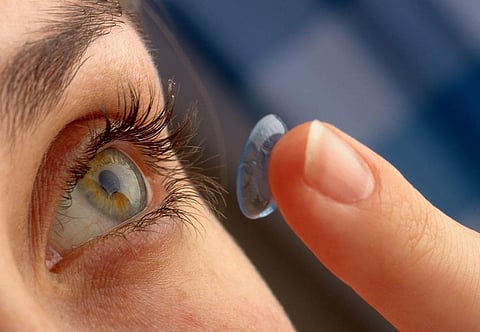
- Home
- न्यूजग्राम
- NewsGram USA
- India
- World
- Politics
- Entertainment
- Culture
- Lifestyle
- Economy
- Sports
- Sp. Coverage
- Misc.
- NewsGram Exclusive
- Jobs / Internships

Eye contact lenses are worn by many people for cosmetic reasons but wearing prescription contacts are also not uncommon. It is also used to correct some severe eye problems such as astigmatism and keratoconus.
By the year 2020, the contacts industry is predicted to reach $13.5 billion. Interestingly, the majority of wearers are female. The contacts are thought to have been invented by Leonardo da Vinci.
Its wearers do not experience any adverse health effects so long as they follow the cleaning instructions as well as its usage and storage. However, isolated cases of its users suffering complications have also been noted.
Types of eye contacts.
According to materials.
Soft contact is made of soft, flexible plastic. They are comfortable to wear and also allow oxygen to pass through the eyes. Different types of contacts are made of these soft materials, and they are;
RGP or rigid gas permeable lenses are also called hard contacts, and they are made from plastic or other hybrid materials. They are somewhat stiff, so they hold their shape very well, but they also allow oxygen to pass through the lenses and the eyes.
RGP lenses are mainly used for prescription contacts and the special ones that are used for vision correction such as keratoconus and astigmatism. It is also the preferred choice for people who have allergic tendencies and protein deposits in the eyes.
According to functions.
These are primarily engineered to correct vision problems such as astigmatism, long-sightedness, and short-sightedness as well as presbyopia.
These contacts are used to alter the appearances of an individuals' eye color temporarily. In Asian countries, cosmetic lenses called circle lenses are very popular. They are different from a regular lens in that their entire lens is colored which makes the wearers' iris appear bigger than normal. Apart from the aesthetic aspect, contacts are used to correct vision problems and other defects.
These lenses are specially engineered to fit individual with defective cornea and complications incurred during surgical procedures such as LASIK surgery. Physical injuries to the eyes are also corrected with scleral contacts.
The unique structure and positioning of the contacts on the cornea allow oxygen to flow freely as well as makes it wearable even for people with sensitive eyes. The contacts are firm but comfortable, and it does not cause any discomfort to the injured eyes.
Advantages of eye contacts.
Disadvantages of eye contacts.
